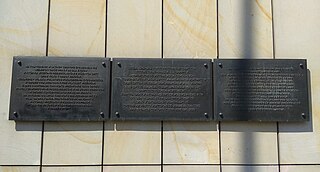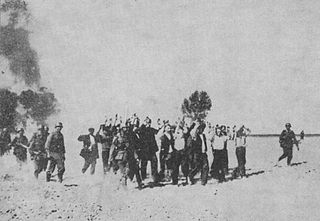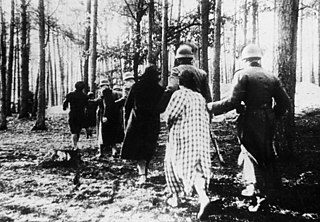 W
WCzarny Las massacre was a mass murder of around 250–300 ethnic Poles during World War II, carried out by the Gestapo on the orders of SS-Hauptsturmführer Hans Krueger in Czarny Las near Stanisławów, during the night of August 14/15, 1941.
 W
WThe Jedwabne pogrom was a massacre of Polish Jews in the town of Jedwabne, German-occupied Poland, on 10 July 1941, during World War II and the early stages of the Holocaust. At least 340 men, women and children were murdered, some 300 of whom were locked in a barn which was then set on fire. About 40 non-Jewish Poles were implicated as being perpetrators of the massacre. German military police were present in the town at the time.
 W
WThe Lipowa 7 camp was a Nazi forced labor concentration camp, primarily for Jews, by Lipowa Street in Lublin, Poland during December 1939 - 1944. In November 1943 nearly all Jewish inmates were exterminated.
 W
WThe Lublin airfield camp was a Nazi forced labor concentration camp, primarily for Jews, at the airfield in Lublin, Poland during 1942–1943, with its prehistory starting from 1939. It also employed and detained (non-Jewish) Polish women. It is also referred to as "(Lublin) airstrip camp", "Flugplatz labor camp", "Alter Flugplatz lager", etc.
 W
WIn July 1941, 25 Polish academics from the city of Lwów along with their families were killed by Nazi German occupation forces. By targeting prominent citizens and intellectuals for elimination, the Nazis hoped to prevent anti-Nazi activity and to weaken the resolve of the Polish resistance movement. According to an eyewitness the executions were carried out by an Einsatzgruppe unit under the command of Karl Eberhard Schöngarth with the participation of Ukrainian translators in German uniforms.
 W
WThe Mass murders in Tykocin occurred in August 25, 1941, during World War II, where the local Jewish population of Tykocin (Poland) was killed by German Einsatzkommando.
 W
WThe pacification actions in German-occupied Poland during World War II were one of many punitive measures designed to inflict terror on the civilian population of local villages and towns with the use of military and police force. They were an integral part of the war of aggression against the Polish nation waged by Nazi Germany since September 1, 1939. The projected goal of pacification operations was to prevent and suppress the Polish resistance movement in World War II nevertheless, among the victims were children as young as 1.5 year old, women, fathers attempting to save their families, farmers rushing to rescue livestock from burning buildings, patients, victims already wounded, and hostages of many ethnicities including Poles and Jews.
 W
WThe Palmiry massacre was a series of mass executions carried out by Nazi German forces, during World War II, near the village of Palmiry in the Kampinos Forest northwest of Warsaw.
 W
WThe Sikorski–Mayski Agreement was a treaty between the Soviet Union and Poland, signed in London on 30 July 1941. Its name is taken from its two most notable signatories: Polish Prime Minister Władysław Sikorski and Soviet Ambassador to the United Kingdom Ivan Mayski.
 W
WThe Soldau concentration camp established by Nazi Germany during World War II was a concentration camp for Polish and Jewish prisoners. It was located in Działdowo, a town in north-eastern Poland, which after the Nazi-Soviet invasion of Poland in September 1939 was annexed into the Province of East Prussia.
 W
WSzczuczyn pogrom was the massacre of some 300 Jews in the community of Szczuczyn carried out by its Polish inhabitants in June 1941 after the town was bypassed by the invading German soldiers in the beginning of Operation Barbarossa. The June massacre was stopped by German soldiers.
 W
WThe Polish White Book is a semi-official name of a series of comprehensive reports published during World War II by the Ministry of Information of the Polish government-in-exile in London, England, dealing with Polish-German relations before and after the 1939 German-Soviet aggression against Poland. Each publication, released in English, French, German and Polish between 1940 and 1941, consisted of official documents and affidavits, supplemented with an overview by the Ministry. Notably, the Polish White Book was released in parallel with The Black Book of Poland series by G.P. Putnam's Sons of New York, published in London by Hutchinson & Co under a differing title in 1942.